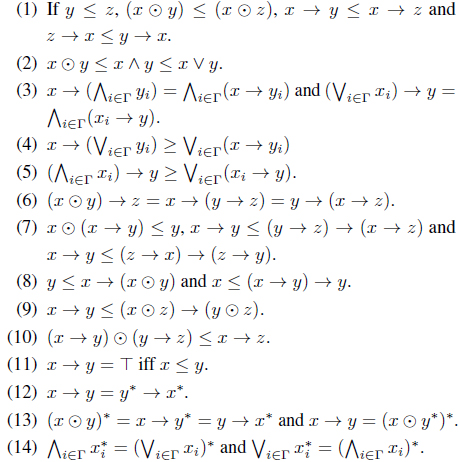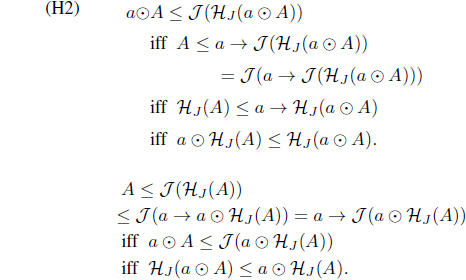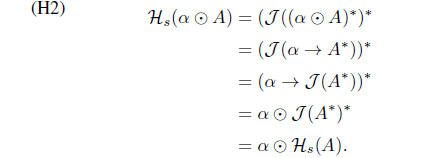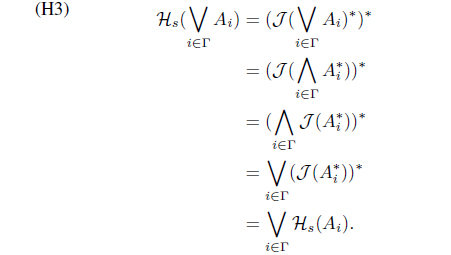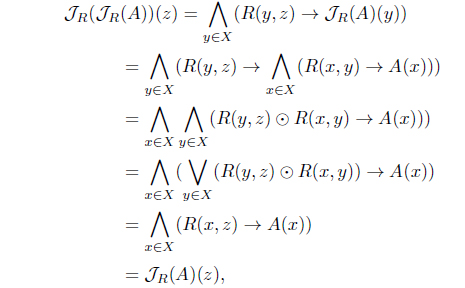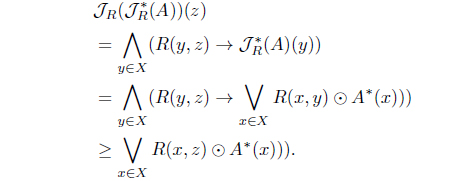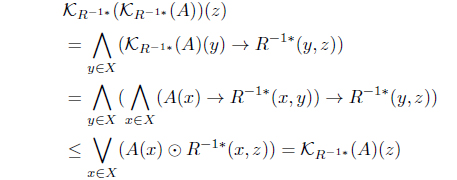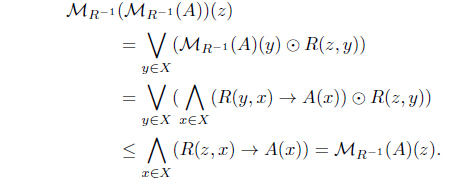Pawlak [1, 2] introduced rough set theory as a formal tool to deal with imprecision and uncertainty in data analysis. Hájek [3] introduced a complete residuated lattice which is an algebraic structure for many valued logic. Radzikowska and Kerre [4] developed fuzzy rough sets in complete residuated lattice. Bělohlávek [5] investigated information systems and decision rules in complete residuated lattices. Lai and Zhang [6, 7] introduced Alexandrov L-topologies induced by fuzzy rough sets. Kim [8, 9] investigate relations between lower approximation operators as a generalization of fuzzy rough set and Alexandrov L-topologies. Algebraic structures of fuzzy rough sets are developed in many directions [4, 8, 10]
In this paper, we investigate the properties of L-lower approximation operators as a generalization of fuzzy rough set in complete residuated lattices. We study relations lower (upper, join meet, meet join) approximation operators and Alexandrov L-topologies. Moreover, we give their examples as approximation operators induced by various L-fuzzy relations.
Definition 1.1. [3, 5] An algebra (L,∧,∨,⊙,→,⊥,⊤) is called a complete residuated lattice if it satisfies the following conditions:
(C1) L = (L,≤,∨,∧,⊥,⊤) is a complete lattice with the greatest element ⊤ and the least element ⊥;
(C2) (L,⊙,⊤) is a commutative monoid;
C3) x ⊙ y ≤ z iff x ≤ y → z for x, y, z ∈ L
Remark 1.2. [3, 5] (1) A completely distributive lattice L = (L,≤,∨,∧ = ⊙,→, 1, 0) is a complete residuated lattice defined by
(2) The unit interval with a left-continuous t-norm ⊙,
is a complete residuated lattice defined by
In this paper, we assume (L,∧,∨,⊙,→,* ⊥,⊤) is a complete residuated lattice with the law of double negation;i.e. x** = x. For 𝛼 ∈ L, A,⊤x ∈ LX,
and
Lemma 1.3. [3, 5] For each x, y, z, xi, yi ∈ L, we have the following properties.
Definition 1.4. [8, 9]
(1) A map H : LX → LX is called an L-upper approximation operator iff it satisfies the following conditions
(2) A map 𝒥 : LX → LX is called an L-lower approximation operator iff it satisfies the following conditions
(3) A map K : LX → LX is called an L-join meet approximation operator iff it satisfies the following conditions
(4) A map M : LX → LX is called an L-meet join approximation operator iff it satisfies the following conditions
Definition 1.5. [6, 9] A subset 𝜏 ⊂ LX is called an Alexandrov L-topology if it satisfies:
Theorem 1.6. [8, 9]
(1) 𝜏 is an Alexandrov topology on X iff 𝜏⁎ = {A* ∈ LX | A ∈ 𝜏} is an Alexandrov topology on X.
(2) If H is an L-upper approximation operator, then 𝜏H = {A ∈ LX | H(A) = A} is an Alexandrov topology on X.
(3) If 𝒥 is an L-lower approximation operator, then 𝜏𝒥 = {A ∈ LX | 𝒥 (A) = A} is an Alexandrov topology on X.
(4) If K is an L-join meet approximation operator, then 𝜏K = {A ∈ LX | K(A) = A*} is an Alexandrov topology on X.
(5) If M is an L-meet join operator, then 𝜏M = {A ∈ LX | M(A) = A*} is an Alexandrov topology on X.
Definition 1.7. [8, 9] Let X be a set. A function R : X × X → L is called:
If R satisfies (R1) and (R3), R is called a L-fuzzy preorder.
If R satisfies (R1), (R2) and (R3), R is called a L-fuzzy equivalence relation
Theorem 2.1. Let 𝒥 : LX → LX be an L-lower approximation operator. Then the following properties hold.
(1) For A ∈ LX,.
(2) Define HJ (B) = ∧{A | B ≤ 𝒥 (A)}. Then HJ : LX → LX with
is an L-upper approximation operator such that (HJ ,𝒥 )
is a residuated connection;i.e.,
HJ (B) ≤ A iff B ≤ 𝒥 (A).
Moreover, 𝜏𝒥 = 𝜏HJ .
(3) If 𝒥 (𝒥 (A)) = 𝒥 (A) for A ∈ LX, then HJ (HJ (A)) = HJ (A) for A ∈ LX such that 𝜏𝒥 = 𝜏HJ with
(4) If 𝒥 (𝒥 *(A)) = 𝒥 *(A) for A ∈ LX, then 𝒥 (𝒥 (A)) = 𝒥 (A) such that
(5) Define Hs(A) = 𝒥 (A*)*. Then Hs : LX → LX with
is an L-upper approximation operator. Moreover, 𝜏Hs = (𝜏𝒥 )* = (𝜏HJ )*.
(6) If 𝒥 (𝒥 (A)) = 𝒥 (A) for A ∈ LX, then
Hs(Hs(A)) = Hs(A)
for A ∈ LX such that 𝜏Hs = (𝜏𝒥 )* = (𝜏HJ )*. with
(7) If 𝒥 (𝒥 *(A)) = 𝒥 *(A) for A ∈ LX, then
such that
(8) Define KJ (A) = 𝒥 (A*). Then KJ : LX → LX with
is an L-join meet approximation operator.
(9) If 𝒥 (𝒥 (A)) = 𝒥 (A) for A ∈ LX, then
for A ∈ LX such that 𝜏KJ = (𝜏𝒥 )* with
(10) If 𝒥 (𝒥 *(A)) = 𝒥 *(A) for A ∈ LX, then
such that
(11) Define MJ (A) = (𝒥 (A))*. Then MJ : LX → LX with
is an L-meet join approximation operator. Moreover, 𝜏MJ = 𝜏𝒥 .
(12) If 𝒥 (𝒥 (A)) = 𝒥 (A) for A ∈ LX, then for A ∈ LX such that 𝜏MJ = (𝜏𝒥 )* with
(13) If 𝒥 (𝒥 *(A)) = 𝒥 *(A) for A ∈ LX, then
such that
(14) Define KHJ (A) = (HJ (A))*. Then KHJ : LX → LX with
is an L-meet join approximation operator. Moreover, 𝜏KHJ = 𝜏𝒥 .
(15) If 𝒥 (𝒥 (A)) = 𝒥 (A) for A ∈ LX, then
for A ∈ LX such that 𝜏KHJ = (𝜏𝒥 )* with
(16) If for A ∈ LX, then
such that
(17) Define MHJ (A) = HJ (A*). Then MHJ : LX → LX
with
is an L-join meet approximation operator. Moreover, 𝜏MHJ = (𝜏𝒥 )*.
(18) If 𝒥 (𝒥 (A)) = 𝒥 (A) for A ∈ LX, then
for A ∈ LX such that 𝜏MHJ = (𝜏𝒥 )* with
(19) If for A ∈ LX, then
such that
(20) (KHJ ,KJ ) is a Galois connection;i.e,
A ≤ KHJ (B) iff B ≤ KJ (A).
Moreover, 𝜏KJ = (𝜏KHJ )*.
(21) (MJ ,MHJ ) is a dual Galois connection;i.e,
MHJ (A) ≤ B iff MJ (B) ≤ A.
Moreover, 𝜏MJ = (𝜏MHJ )*.
Proof.
(1) Since , by (J2) and (J3),
(2) Since
iff , we have
(H1) Since HJ (A) ≤ HJ (A) iff A ≤ 𝒥 (HJ (A)), we have A ≤ 𝒥 (HJ (A)) ≤ HJ (A).
(H3) By the definition of HJ , since HJ (A) ≤ HJ (B) for B ≤ A, we have
Since 𝒥 (∨i∈𝚪 HJ (Ai)) ≥ 𝒥 (HJ (Ai)) ≥ Ai, then
𝒥 (∨i∈𝚪 HJ (Ai)) ≥ ∨i∈𝚪 Ai. Thus
Thus HJ : LX → LX is an L-upper approximation operator. By the definition of HJ , we have
HJ (B) ≤ A iff B ≤ 𝒥 (A).
Since A ≤ 𝒥 (A) iff HJ (A) ≤ A, we have 𝜏HJ = 𝜏𝒥 .
(3) Let 𝒥 (𝒥 (A)) = 𝒥 (A) for A ∈ LX. Since 𝒥 (B) ≥ HJ (A) iff 𝒥 (𝒥 (B)) = 𝒥 (B) ≥ A from the definition of HJ , we have
(4) Let 𝒥 *(A) ∈ 𝜏𝒥 . Since 𝒥 (𝒥 *(A)) = 𝒥 *(A),
𝒥 (𝒥 (A)) = 𝒥 (𝒥 *(𝒥 *(A))) = (𝒥 (𝒥 *(A)))* = 𝒥 (A).
Hence 𝒥 (A) ∈ 𝜏𝒥 ; i.e. 𝒥 *(A) ∈ (𝜏𝒥 )*. Thus, 𝜏𝒥 ⊂ (𝜏𝒥 )*.
Let A ∈ (𝜏𝒥 )*. Then A* = 𝒥 (A*). Since 𝒥 (A) = 𝒥 (𝒥 *(A*)) = 𝒥 *(A*) = A, then A ∈ 𝜏𝒥 . Thus, (𝜏𝒥 )* ⊂ 𝜏𝒥 .
(5) (H1) Since 𝒥 (A*) ≤ A*, Hs(A) = 𝒥 (A*)* ≥ A.
Hence Hs is an L-upper approximation operator such that
Moreover, 𝜏Hs = (𝜏𝒥 )* from:
A = Hs(A) iff A = 𝒥 (A*)* iff A* = 𝒥 (A*).
(6) Let 𝒥 (𝒥 (A)) = 𝒥 (A) for A ∈ LX. Then
Hence
(7) Let 𝒥 (𝒥 *(A)) = 𝒥 *(A) for A ∈ LX. Then
Hence
By a similar method in (4), 𝜏Hs = (𝜏Hs )*.
(8) It is similarly proved as (5).
(9) If 𝒥 (𝒥 (A)) = 𝒥 (A) for A ∈ LX, then
(10) If 𝒥 (𝒥 *(A)) = 𝒥 *(A) for A ∈ LX, then
Since ,
Hence 𝜏KJ = {KJ (A) | A ∈ LX} = (𝜏KJ )*.
(11) , (12), (13) and (14) are similarly proved as (5), (9), (10) and (5), respectively.
(15) If 𝒥 (𝒥 (A)) = 𝒥 (A) for A ∈ LX, then HJ (HJ (A)) = HJ (A). Thus,
Since 𝒥 (A) = A iff HJ (A) = A iff KHJ (A) = A*, 𝜏KHJ = (𝜏𝒥 )* with
(16) If for A ∈ LX, then
(17) , (18) and (19) are similarly proved as (14), (15) and (16), respectively.
(20) (KHJ ,KJ ) is a Galois connection;i.e,
A ≤ KHJ (B) iff A ≤ (HJ (B))*
iff HJ (B) ≤ A* iff B ≤ 𝒥 (A*) = KJ (A)
Moreover, since A* ≤ KJ (A) iff A ≤ KHJ (A*), 𝜏KJ = (𝜏KHJ )*.
(21) (MJ ,MHJ ) is a dual Galois connection;i.e,
MHJ (A) ≤ B iff HJ (A*) ≤ B
iff A* ≤ 𝒥 (B) iff MJ (B) = (𝒥 (B))* ≤ A.
Since MHJ (A*) ≤ A iff MJ (A) ≤ A*, 𝜏MJ = (𝜏MHJ )*.
Let R ∈ LX × X be an L-fuzzy relation. Define operators as follows
Example 2.2. Let R be a reflexive L-fuzzy relation. Define 𝒥R : LX → LX as follows:
(1) (J1) 𝒥R(A)(y) ≤ R(y, y) → A(y) = A(y): 𝒥R satisfies the conditions (J1) and (J2) from:
Hence 𝒥R is an L-lower approximation operator.
(2) Define HJR(B) = ∨ {A | B ≤ 𝒥R(A)}. Since
then
By Theorem 2.1(2), HJR = HR-1 is an L-upper approximation operator such that (HJR,𝒥R) is a residuated connection;i.e.,
HJR(A) ≤ B iff A ≤ 𝒥R(B).
Moreover, 𝜏HJR = 𝜏𝒥R.
(3) If R is an L-fuzzy preorder, then R-1 is an L-fuzzy preorder. Since
By Theorem 2.1(3), HJR(HJR(A)) = HJR(A): By Theorem 2.1(3), 𝜏HJR = 𝜏𝒥R with
(4) Let R be a reflexive and Euclidean L-fuzzy relation. Since R(x, z) ⊙ R(y, z) ⊙ A*(x) ≤ R(x, y) ⊙ A*(x) iff R(x, z) ⊙ A*(x) ≤ R(y, z) → R(x, y) ≤ A*(x),
Thus, .
By Theorem 2.1(4), 𝒥R(𝒥R(A)) = 𝒥R(A) for A ∈ LX.
Thus, 𝜏𝒥R = (𝜏𝒥R)* with
(5) Define Hs(A) = 𝒥R(A*)*. By Theorem 2.1(5), Hs = HR is an L-upper approximation operator such that
Moreover, 𝜏Hs = 𝜏HR = (𝜏HJR )*.
(6) If R is an L-fuzzy preorder, then 𝒥R(𝒥R(A)) = 𝒥R(A) for A ∈ LX. By Theorem 2.1(6), then Hs(Hs(A)) = Hs(A) for A ∈ LX such that 𝜏Hs = (𝜏𝒥R)* = (𝜏HJR )* with
(7) If R is a reflexive and Euclidean L-fuzzy relation, then
(8) Define KJR(A) = 𝒥R(A*). Then KJR : LX → LX with
is an L-join meet approximation operator. Moreover, 𝜏KJR = (𝜏𝒥R)*.
(9) R is an L-fuzzy preorder, then 𝒥R(𝒥R(A)) = 𝒥R(A) for A ∈ LX. By Theorem 2.1(9), for A ∈ LX such that 𝜏KJR = (𝜏𝒥R)* with
(10) If R is a reflexive and Euclidean L-fuzzy relation, then for A ∈ LX. By Theorem 2.1(10), such that
(11) Define MJR(A) = (𝒥R(A))*. Then MJR : LX → LX with
is an L-join meet approximation operator. Moreover, 𝜏MJR = 𝜏𝒥R.
(12) If R is an L-fuzzy preorder, then 𝒥R(𝒥R(A)) = 𝒥R(A) for A ∈ LX. By Theorem 2.1(12), for A ∈ LX such that 𝜏MJR = 𝜏𝒥R with
(13) If R is a reflexive and Euclidean L-fuzzy relation, then for A ∈ LX. By Theorem 2.1(13), such that
(14) Define KHJR (A) = (HJR(A))*. Then
KHJR : LX → LX
with
is an L-join meet approximation operator. Moreover, 𝜏KR-1 = 𝜏𝒥R = 𝜏HR-1 .
(15) If R is an L-fuzzy preorder, then 𝒥R(𝒥R(A)) = 𝒥R(A) for A ∈ LX. By Theorem 2.1(15), for A ∈ LX such that 𝜏KR-1 = 𝜏𝒥R = 𝜏HR-1 with
(16) Let R-1 be a reflexive and Euclidean L-fuzzy relation. Since
we have
Thus,
Hence
By (K1), such that
(17) Define MHJR (A) = HJR(A*). Then
MHJR : LX → LX
is an L-meet join approximation operator as follows:
Moreover, 𝜏MHJR = (𝜏𝒥R)*.
(18) If R is an L-fuzzy preorder, then 𝒥R(𝒥R(A)) = 𝒥R(A) for A ∈ LX. By Theorem 2.1(18),
for A ∈ LX such that 𝜏MHJR = (𝜏𝒥 )* with
(19) Let R-1 be a reflexive and Euclidean L-fuzzy relation.
Since
then (R(y, x) → A(x)) ⊙ R(z, y) ≤ R(z, x) → A(x).
Thus,
By (M1), such that
(20) (KHJR = KR-1* ,KJR = KR* ) is a Galois connection; i.e, A ≤ KHJR (B) iff B ≤ KJR(A): Moreover, 𝜏KJR = (𝜏KHJR )*.
(21) (MJR = MR,MHJR = MR-1 ) is a dual Galois connection; i.e, MHJR (A) ≤ B iff MJR(B) ≤ A. Moreover, 𝜏MJR = (𝜏MHJR )*.









